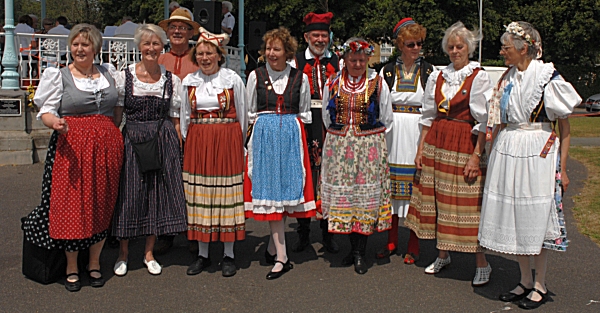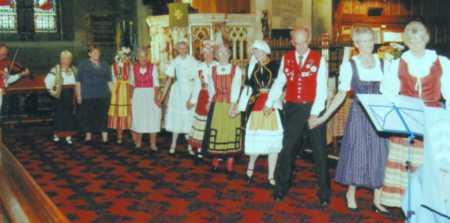Folkestone District National Dance Group
An Affiliated Group of the Society for International Folk Dancing (SIFD).

European Folk Dancing in Folkestone
7:30pm Tuesday evenings during term time
Newington Village Hall, the Street, Newington,
Folkestone, Kent CT18 8AU
For further details telephone Barbara on ![]()
We perform folk dances, mainly from European countries (including the UK). We dance to live music - two accordion players (one of whom doubles on the fiddle).
The first session is a 'taster' and is free to newcomers. Thereafter, we collect a modest fee at each session.
Visitors and newcomers are welcome as dancers, musicians or both. There is no long-term commitment. Most of our folk dances are
easy to perform. Previous experience is not required to join in with the dancing. Our sessions are fun, provide moderate
exercise and improve co-ordination. They can be included amongst the many 'alternative therapies' now available for the mind
and body.
In the year 2000, the Group celebrated its 50th anniversary. The party was attended by our founder, Olive Field
who died in 2005 aged 90. At her memorial service the group performed ‘Datchko Kolo’ a dance from Yugoslavia. The
dance is a typical Kolo or simple line dance from the Balkan regions with a catchy tune and rhythm, not requiring a
partner.
Other dances in the repertoire include Swedish ‘Engelska per tre’, ‘Danish Schottische’, and Swiss and French pair dances.
Many of the dances have interesting floor patterns similar to our own English dances. We include a range of Israeli
dances in our practice evenings and add local flavour by dancing some ‘Kentish Hops’ – English, Playford style set dances
some of which date from the 18th century. For the heavy footed bucholic members we include ‘Oxdans’ from Sweden and
‘Ochsengalop’ from Austria, but not too often!

Performing at a local church - a chance to dress up
What is International Folk Dancing?
Many people immediately think of Cossack dancing or one of the other types of showy, leg-breaking dances they have
seen performed by display companies. However most of the traditional dances are done by everyone in the village often
as part of a convivial evening and are simple and enjoyable. The display teams naturally pick the most energetic and
complex dances to show off whilst we pick those we enjoy (and can do).
A better example of what traditional folk dancing is all about is given by Greek dancing which is mainly done in
lines. At the front are the best dancers who show off with fancy footwork and energy. The rest of the village arrange
themselves behind them in descending order of confidence. At the end are those who can at least follow the line and join
in the singing. We aspire to be further up from the back end of the line towards the middle! (Note: it is the height of bad
manners to join the front of a Greek line of dance unless you are either an expert or are paying for the musicians!).
There are a wide variety of dance types. Many are done in a line or circle where footwork is important, some are more
similar to the English/Scottish tradition and are performed in sets where the steps are less important than the patterns.
As a result there is something for everyone. There are a whole series of simple dances from around the world with various
short sequences of steps at different speeds. These allow one to learn the basic steps painlessly. Rather than concentrate
on the dances of single country and learn the difficult dances, we prefer to experience the different styles from as many
countries as we can. Our repertoire is based on the dances we have tried and tested over many years and found to be do-able
and enjoyable.
